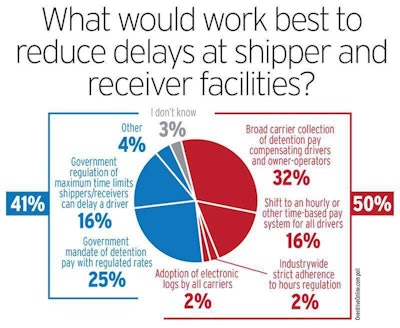

In a well-participated-in poll on loading and unloading delays at shippers and receivers, conducted here on OverdriveOnline.com late last month, respondents weighed in on a variety of solutions to the long-grappled-with problem, with 50 percent favoring some kind of industry-focused solution, 41 percent actually taking the line that the federal government should have a role in detention.
As has been written about in Overdrive over the last several years, Federal Motor Carrier Safety Administrator Anne Ferro has been up-front about her intent to use the “bully pulpit” to influence shippers and receivers, but at once she’s also stressed lack of regulatory authority to get into such business. There have been some efforts — notably by Rep. Peter DeFazio — to introduce new authorities with legislation that would put regulated limits on detention, and FMCSA is currently involved in a study on the subject of what FMCSA can further do to help combat the problem. Ferro most recently said she expected results from it in 2015.
So much for the here and now for that avenue, though industry in some quarters has seen the extent of the problem and responded by instituting broader detention-pay programs. Marten Transport, for instance, in 2011 moved to a pay scheme for all detained loads on both ends, regardless of whether the carrier was actually collecting detention from shippers and receivers. Marten Recruiting Director Tim Norlin describes the program as paying $20/hour for all time spent waiting over an initial two hours to all company drivers as well as owner-operators leased to the refrigerated carrier.
At once, Norlin adds, “We’re still fighting the same battle” with customers over improving efficiency of loading and unloading. “But it’s not fair to have the driver stuck in the middle as always.”
“Costco used to be a nightmare place to go into. Hours of checking into the gate and waiting in line in the office, and waiting again for your signed bills. Now they’re one of my favorite places to go…. I don’t know what prompted them to change, but kudos to them for figuring it out!” –Cory Davidson via OverdriveOnline.com
Since putting the program in place 2.5 years ago, Marten sales staff “have worked very hard during rate negotiations and contract negotiations to put verbiage in there as to what’s acceptable in terms of detention, and they’ve had some fair success…. There are some customers who wouldn’t deal with it, and their detention was six hours or more.” Marten has walked away from some of those contracts since. “It didn’t make sense, with the new hours of service, economically to deal with those customers. Some have come back to us, and they’ve done some things to fix the problem.”
On the whole, it’s translated to greater efficiency across the entire operation and down to the level of the individual driver. Since instituting the program, miles per unit among Marten drivers were 9 percent between the second quarter of 2011 and the same quarter this year, “giving drivers an additional $1,000 on average per quarter,” Norlin notes.
Nearly a third of respondents to the detention poll think more carriers need to take such an aggressive approach on collecting detention — and distributing it to drivers — to combat the excessive detention problem. Early results in another poll probing the extent to which drivers and owner-operators are being compensated in some way for detention, which you can participate in via this link, suggest that nearly 40 percent of the industry is still in the dark, with no detention-pay program in place.
Following, find a round-up of more reader views on the subject:
John Scott: I think a lot of trucking issues could begin to be solved if drivers were required to be paid for all duties associated with their job. It does not matter how that is paid for. It could be a combination of increased rates, agreed-upon contracts between carriers and shippers or a simple charge based on time at a shipper or receiver. Consider how much on-duty time is not compensated for by anyone — this includes fueling, unloading/loading, inspections, breakdowns and so on. The job of the truck driver is filled with too many unpaid hours that still have to be worked.
Joe Ammons: Mandatory hourly wage that equals the hourly gain by driver while in transit. If he averages $21/hour while driving he gets $21/hour at a dock. Drop the FLSA exemption. (Owner-operator Ammons’ petition to Congress to legislate removal of the exemption of employee truck drivers from the Fair Labor Standards Act’s wage and time protections made news here earlier this year. Since its launch, the petition has garnered more than 500 signatures. Ammons argues that given an EOBR/ELD mandate coming, the justification for the exemption, written into law in the 1930s, no longer applies. Speaking of EOBRs, carriers large and small have found adoption to be a helpful tool in proving detention to skeptical shippers to force efficiency improvements.)
Zachary Bell: I fully agree, but some have taken it too far. Sweeping the trash out of the trailer only takes 5-10 minutes, and some want to charge for that. But for detention and fueling, inspections and breakdowns, I would like to see a pay system for that otherwise uncompensated on-duty time.
Kevin J. Reidy: So many different problems in our industry are directly caused by shippers and receivers, and will never be solved until they are made to pay. After two hours waiting past the appointment time, the driver needs to be compensated by the entity doing the detaining. If you are in the act of being loaded or unloaded, you are on duty — you are to be paid for that time.
For far too long, drivers have been expected to work for free, and the trucking companies that hire them are so used to this free labor provided by their employees they will fight tooth and nail right along with the shipper/receiver to keep things as they are, instead of sticking the customers with a detention bill.
The idea of lumpers from way back, when you had a bill of sale for the perishable product, are long gone. We have Bills of Lading now — none of that stuff belongs to me, so why do I have to pay to unload the product ordered by someone else and that belongs to them?
Whether or not it can fit on their racking system is none of my concern — I don’t work for the warehouse. I don’t care how it’s stacked. It’s my job to bring the correct product in good condition, correct count … and that is it….
Since the FMCSA has already stated that shippers and receivers are outside the scope of their regulatory umbrella, maybe the Department of Labor needs to look into how truckers are forced to work for free. The IRS should also be interested in unpaid labor, as that is tax revenue they are missing out on, and most definitely not legal. They have ruled against other businesses that forced employees to work for free or off the clock to pay back taxes on their employees — why not trucking companies who expect you to work, but don’t pay?
Cory Davidson: $130 detention pay for even a two-hour delay doesn’t cut it when you’ve now missed your next appointment and are held over a whole day. The hope would be that if detention is federally mandated, and they’re getting hit with the fees for every truck, that it would inspire them to evaluate their inefficient loading/unloading procedures. We know it can be done faster. Case in point — Costco used to be a nightmare place to go into. Hours of checking into the gate and waiting in line in the office, and waiting again for your signed bills. Now they’re one of my favorite places to go. The guard shack takes your bills, you back in with a beeper. When it goes off, drive back to the guard and out without even knowing what the inside of that place looks like! I don’t know what prompted them to change, but kudos to them for figuring it out!










